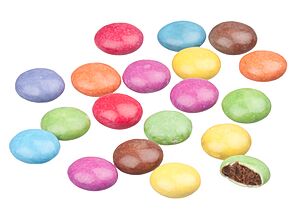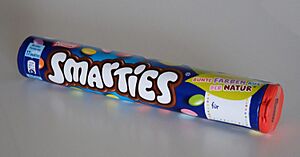Smarties facts for kids
 |
|
 |
|
| Owner | Nestlé |
|---|---|
| Country | United Kingdom |
| Introduced | 1937 |
| Markets | Europe, Canada, South Africa, Australia, Middle East, Philippines, Thailand, Indonesia, Malaysia, Japan, South Korea |
| Previous owners | Rowntree's |
| Website | |
Smarties are colorful, button-shaped chocolates. They have a hard candy shell and a chocolate center. These tasty treats have been made since 1937. They were first created by a company called Rowntree's in the United Kingdom. Today, they are made by Nestlé.
Smarties are shaped like flattened balls. They are about 5 millimeters (0.2 inches) thick and 12 millimeters (0.5 inches) wide. You can find them in eight bright colors: red, orange, yellow, green, blue, mauve (a light purple), pink, and brown. For a short time, blue Smarties were replaced with white ones in some places. This happened while scientists worked to find a natural blue color.
Smarties are mostly sold in Europe, Canada, South Africa, Australia, and the Middle East. They are not usually sold in the United States. In the US, another company makes a different type of candy called "Smarties."
Contents
The Story of Smarties
How Smarties Began
The company Rowntree's, from York, England, started making "Chocolate Beans" way back in 1882. In 1937, they changed the name to "Smarties Chocolate Beans." Soon after, they shortened it to just "Smarties."
At first, the candies were sold loosely. But Rowntree's wanted to make their brand more famous. They had already seen success selling other candies in cardboard tubes. So, they started selling Smarties in these tubes too. This new packaging and the candy were marketed to children. The cardboard tubes were popular because kids could use them for crafts. The plastic caps on the tubes were also collected, as each one had a letter of the alphabet on it.
Changes to Packaging
In February 2005, the classic round Smarties tube changed. It became a hexagonal (six-sided) design. Nestlé said this change made the brand "fresh and appealing" to young people. The new package is also lighter and smaller. The lid is now a hinged piece of cardboard that clips shut.
The new lid still has a letter, just like the old plastic ones. But now it's part of a question, like "what [letter] is a [thing]?" You can find the answer when you open the lid. The hexagonal box is made from one piece of card. It can also be stacked easily, which is good for stores.
Where Smarties Are Made
Smarties are no longer made in York, England. In October 2007, the production moved to Germany. A large part of Smarties were already made there. Outside of Europe, Nestlé's biggest Smarties factory is in Toronto, Canada. Nestlé has been making products there since 1918.
In 1998, Nestlé tried to trademark the tubular shape of the Smarties package. They sued another company that was selling similar candies in a tube. However, a court in Denmark decided that a basic shape cannot be trademarked. They ordered the trademark to be removed.
In 2021, Nestlé moved the production of a similar candy called Lentilky from Czechia to Hamburg, Germany. The ingredients for Lentilky are now also similar to Smarties.
Smarties Colors
The History of Colors
In the past, there was a light-brown Smartie. This color was replaced in 1988 by a blue Smartie. This change was part of a campaign when Nestlé bought Rowntree Mackintosh Confectionery. People even wore "I Support Blue Smarties" pins!
Before 1958, dark-brown Smarties had a plain chocolate center. Light-brown ones tasted like coffee. Orange Smarties used to have orange-flavored chocolate inside. Today, the orange flavor is only in the candy shell.
Natural Colors
In 2006, Nestlé announced they would remove all artificial colors from Smarties in the United Kingdom. They wanted to use only natural dyes. At first, they couldn't find a natural blue dye. So, blue Smarties were removed and replaced with white ones. Some people thought blue Smarties caused hyperactivity, but this was a misunderstanding.
In February 2008, blue Smarties came back! They now use a natural blue dye made from a type of algae called spirulina. This replaced the old artificial blue dye. Artificial colors were also removed from Smarties in Canada in March 2009. Blue Smarties were added back to the Canadian market in May 2010.
Red Smarties used to get their color from cochineal. This is a dye made from insects. Now, in the United Kingdom, a pigment from red cabbage is used instead.
Different Kinds of Smarties
Smarties are not just sold as loose candies. You can also find them in chocolate bars and chocolate eggs. There's even Smarties Fusion ice cream, which mixes chocolate and vanilla ice cream with Smarties pieces.
McDonald's used to sell a Smarties McFlurry. It was stopped for a while in 2012, brought back in 2014, and then removed again in late 2015. It was replaced by Oreo, but in some countries, you can still get both. In Canada, Dairy Queen restaurants used to have a Smarties Blizzard. This was replaced by an M&M's Blizzard in 2015. However, the Smarties Blizzard returned to the menu in early 2018.
In 1997, bigger "Giant Smarties" were introduced. In 2004, "Fruity Smarties" came out. Another type of Smarties had white chocolate instead of milk chocolate. These were first called "Smarctic Frost Bites" and later "White Chocolate Smarties."
In 1998, a product called "Smarties Secrets" was released. These candies had different designs, colors, and flavors. The packaging also came with a small comic book. This product is no longer available.
In Canada, there was a special edition of red and white Smarties. The white Smarties had a red maple leaf on them, like the Canadian flag. During holidays like Halloween, Christmas, and Valentine's Day, you can find special Smarties packaging. For example, Halloween Smarties are sometimes called "Scaries." Valentine's Day Smarties only have pink and red candies. In Canada, Nestlé also sells Peanut and Peanut Butter Smarties.
Around Christmas, Nestlé in Australia and Canada often sells Smarties in red, green, and white colors.
Smarties come in different types of packaging in various countries. You can buy them in rectangular boxes, giant tubes, or in stand-up or paper bags. In Australia and New Zealand, they are sold in 410-gram bags.
In the UK in 1995-1996, there was a "Smartian edition." The lids had different alien symbols, like a rocket ship. There were also four alien characters: Babok (blue), Smorg (orange), Yoz (green), and Zock (yellow).
See also
 In Spanish: Smarties para niños
In Spanish: Smarties para niños




